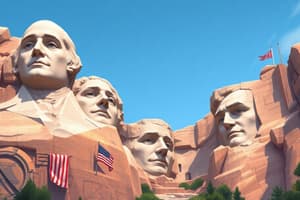Podcast
Questions and Answers
The 'Shrine of Democracy' refers to the Mount ________ National Memorial.
The 'Shrine of Democracy' refers to the Mount ________ National Memorial.
Rushmore
Each president on Mount Rushmore represents key aspects of American ________.
Each president on Mount Rushmore represents key aspects of American ________.
democracy
The monument is carved into ________, showcasing monumental sculpture techniques.
The monument is carved into ________, showcasing monumental sculpture techniques.
granite
Mount Rushmore attracts over two million visitors ________.
Mount Rushmore attracts over two million visitors ________.
The monument serves as a symbol of national pride and American _________.
The monument serves as a symbol of national pride and American _________.
Flashcards are hidden until you start studying
Study Notes
History Of The Monument
- The "Shrine of Democracy" refers to the Mount Rushmore National Memorial.
- Created between 1927 and 1941 by sculptor Gutzon Borglum and his son, Lincoln Borglum.
- Designed to promote tourism and highlight American democracy.
- Features the faces of four U.S. Presidents: George Washington, Thomas Jefferson, Theodore Roosevelt, and Abraham Lincoln.
- Construction faced challenges, including funding, weather, and technical difficulties.
Symbolism Of Democracy
- Each president represents key aspects of American democracy:
- George Washington: Leadership and the birth of the nation.
- Thomas Jefferson: Declaration of Independence and the values of freedom.
- Theodore Roosevelt: Progressive reforms and the role of the U.S. in global affairs.
- Abraham Lincoln: Preservation of the Union and equality.
- The monument serves as a reminder of the ideals and struggles of American democracy.
- Represents unity and the collective identity of the American people.
Architectural Significance
- The monument is carved into granite, showcasing monumental sculpture techniques.
- The scale is impressive; each presidential face is about 60 feet tall.
- Innovative techniques used for the time, including dynamite for rough shaping and finer tools for detailing.
- Designed to withstand harsh weather conditions and erosion over time.
- The site integrates natural landscape with artistic expression.
Visitor Experience
- Attracts over two million visitors annually.
- Features a visitor center with educational exhibits about the monument’s history and construction.
- Offers trails and viewpoints for various perspectives of the monument.
- Hosts annual events, including a July 4th celebration with fireworks.
- Provides opportunities for educational programs and ranger-led tours.
Cultural Impact
- A symbol of national pride and American exceptionalism.
- Frequently referenced in popular culture, art, and literature.
- Inspires discussions on patriotism, history, and democracy.
- Serves as a backdrop for political speeches and gatherings.
- Influences tourism and the economy of the surrounding region.
History Of The Monument
- Mount Rushmore, known as the "Shrine of Democracy," was sculpted by Gutzon Borglum and his son, Lincoln Borglum, from 1927 to 1941.
- The project aimed to enhance tourism and celebrate the principles of American democracy.
- Features the likenesses of four significant U.S. Presidents: George Washington, Thomas Jefferson, Theodore Roosevelt, and Abraham Lincoln.
- Experienced obstacles such as funding shortages, adverse weather, and complex technical challenges during construction.
Symbolism Of Democracy
- George Washington symbolizes leadership and the founding of the nation.
- Thomas Jefferson embodies the principles of the Declaration of Independence and individual freedoms.
- Theodore Roosevelt represents progressive reforms and America’s role in international affairs.
- Abraham Lincoln signifies the preservation of the Union and the pursuit of equality.
- The monument epitomizes the ideals and historical struggles central to American democracy and reflects national unity.
Architectural Significance
- Carved from granite, the monument exemplifies monumental sculpture techniques of the era.
- Each presidential face measures approximately 60 feet in height, showcasing impressive scale.
- Employed innovative methods for its time, including dynamite for initial shaping and detailed chiseling for refinement.
- Designed for durability against harsh weather and erosion threats.
- Integrated the natural landscape with artistic elements for a harmonious aesthetic.
Visitor Experience
- Attracts over two million visitors each year, indicating its cultural and historical significance.
- Contains a visitor center offering educational exhibits on the monument’s creation and legacy.
- Features trails and viewpoints that provide diverse perspectives of the sculpture.
- Hosts annual events, including a July 4th celebration featuring fireworks, fostering community engagement.
- Offers educational programs and ranger-led tours to enhance visitor understanding of the monument's history.
Cultural Impact
- Serves as a powerful symbol of national pride and American exceptionalism.
- Frequently referenced across various cultural platforms, including art, literature, and media.
- Sparks debates surrounding themes of patriotism, history, and democratic values.
- Acts as a prominent backdrop for political events and public gatherings.
- Contributes significantly to the tourism sector and economic vitality of the nearby region.
Studying That Suits You
Use AI to generate personalized quizzes and flashcards to suit your learning preferences.




